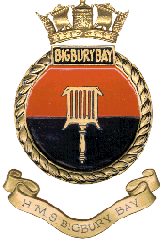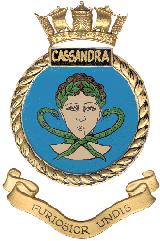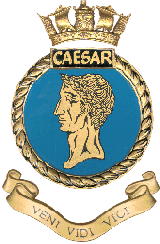
RN Home Page
Contents
Introduction
These pages capture the sea-going portion of a career in the Royal Navy. I served for nearly 14 years, joining H.M.S. Fisgard in May 1953 as an Artificer Apprentice and leaving from H.M.S. Sea Eagle in December 1966 as a Chief Electrical Artificer.
Back to TopHMS Bigbury Bay 1957 – 1959
 My sea-going commenced with HMS Bigbury Bay, an anti-submarine frigate from World
War II. She was to be based in the South Atlantic, operating from Simonstown in South
Africa, and a more pleasant introduction to a life at sea cannot be imagined.
My sea-going commenced with HMS Bigbury Bay, an anti-submarine frigate from World
War II. She was to be based in the South Atlantic, operating from Simonstown in South
Africa, and a more pleasant introduction to a life at sea cannot be imagined.
We sailed from Devonport in November 1957 and bounced all the way to Simonstown, visiting Bathurst in the Gambia (a memorable 21st birthday), Freetown in Sierra Leone, Takoradi in Ghana (was it still the Gold Coast?) and Lagos in Nigeria, where we enjoyed generous hospitality over Christmas 1957. From Lagos we continued via Port Harcourt, Victoria, Pointe Noir and Luanda, arriving in Simonstown in the Cape Province of South Africa in the New Year.
Our timing was impeccable; it was high summer and the hills above the Naval Base were alive with the sound of burning brushwood and our first few days were spent in supporting local efforts to control and extinguish the fires!
Then it was six months of sheer hell, cruising back and forth between Simonstown, Port Elizabeth, East London and Durban, enjoying the warm hospitality of the local population.
All good things have to come to an end however, and the rest of our commission was spent further north, including several spells in the Gulf of Aqaba and trips through the Suez Canal, as the periodic hostilities of the region flared up. One good thing to emerge from this time was a drive through the Jordanian desert to visit Petra, "the rose-red city, half as old as time". Mind you, for someone who had previously viewed horses as a creative alternative to cows when hungry, riding(?) a strange horse down narrow tracks to the canyon floor in order to view the city was an experience to be savoured, but well worth the effort!
Back to TopHMS Cassandra 1960 – 1962
 After a spell ashore in H.M.S. Diligence at Hythe in Hampshire, the base for the
minesweepers and motor torpedo boats of the reserve fleet, it was back to sea in
H.M.S. Cassandra. She was coming to the end of a major modernisation programme in
Chatham dockyard when I joined her, having been in reserve for the previous several
years.
After a spell ashore in H.M.S. Diligence at Hythe in Hampshire, the base for the
minesweepers and motor torpedo boats of the reserve fleet, it was back to sea in
H.M.S. Cassandra. She was coming to the end of a major modernisation programme in
Chatham dockyard when I joined her, having been in reserve for the previous several
years.
Once work was completed we embarked on sea trials, followed by "working up" in and off the Portland Naval Base, before heading east to join the famous 8th Destroyer Squadron in the Far East Fleet, based on Singapore.
The voyage to Singapore was uneventful. After a brief stop in Devonport to replenish stores, we cruised through the Mediterranean, the Suez Canal, the Red Sea and the Indian Ocean before passing through the Malacca Straight to Singapore Naval Base and our role as "canteen boat" of the 8th DS.
Initially Captain 'D' was H.M.S. Cavendish (the "Crabby Dish") until the later arrival of H.M.S. Caesar and her assumption of command, at which time Cavendish returned to the United Kingdom. Cavendish was one of the four members of the "CA" Class to have retained the original open bridge after modernisation, together with Carron, Carysfort and Cavalier: the other four members of the class, comprising Caesar, Cambrian, Caprice and Cassandra had the more modern enclosed bridge. Of the eight "CA"s, only Carron did not serve in the 8th DS, due to prior fire damage which had rendered her gunnery computers un-serviceable.
Back to TopHMS Kent 1962 – 1963
 Returning from the Far East, I enjoyed a spell under training in H.M.S. Collingwood
before crossing the Irish Sea to join H.M.S. Kent in the building yards of Harland
and Wolff in Belfast. Also under construction at this time were H.M.S. Leander, the
name ship of the Leander class of anti-submarine frigates, H.M.S. Fearless, the first
of the two amphibious landing ships (Fearless and Intrepid) and the passenger ship
"Canberra", the latter two ships famous for their roles as members of the fleet that
took part in the liberation of the Falkland Islands in 1982.
Returning from the Far East, I enjoyed a spell under training in H.M.S. Collingwood
before crossing the Irish Sea to join H.M.S. Kent in the building yards of Harland
and Wolff in Belfast. Also under construction at this time were H.M.S. Leander, the
name ship of the Leander class of anti-submarine frigates, H.M.S. Fearless, the first
of the two amphibious landing ships (Fearless and Intrepid) and the passenger ship
"Canberra", the latter two ships famous for their roles as members of the fleet that
took part in the liberation of the Falkland Islands in 1982.
Standing by a ship under construction in Belfast was an interesting experience, not least for the strong sense of history evoked by association with the famous ship builder who had created H.M.S. Belfast, H.M.S. Eagle and the "Titanic", amongst many other splendid vessels.
It was also in Belfast that I first met the lady who later became my wife and that alone leaves me with very happy memories of this period.
My time in Kent was not to last, however. A decision had been taken to reduce the complement of the electrical division and, on reaching Portsmouth after our sea trials, I found myself on the jetty with kit bag and hammock, awaiting transport to H.M.S. Collingwood.
Back to TopHMS Caesar 1964 – 1965
 Following a few months in Collingwood, the inevitable draft chit arrived and I found
myself once more bound for the Far East, flying out to Singapore to join H.M.S. Caesar,
the happiest ship of all. Perhaps this had something to do with being Captain 'D',
rather than canteen boat, but I prefer to think that it was the skipper and crew who
made her such a delight in which to serve.
Following a few months in Collingwood, the inevitable draft chit arrived and I found
myself once more bound for the Far East, flying out to Singapore to join H.M.S. Caesar,
the happiest ship of all. Perhaps this had something to do with being Captain 'D',
rather than canteen boat, but I prefer to think that it was the skipper and crew who
made her such a delight in which to serve.
The flight to Singapore was full of interest, commencing at R.A.F. Lyneham where we boarded a Comet (the world's first jet-powered passenger aircraft) of Transport Command. The flight was staged via several R.A.F. re-fueling stations, firstly to El Adem in Libya, then to Khormaksa in Aden, followed by the island of Gan in the Indian Ocean. A point worthy of mention is the curious, not to say eccentric taste of the R.A.F. cooks at the various ports of call. One of the more memorable meals in, if memory serves, El Adem included curried baked beans!
Gan was our first over-night stop and the following morning we took off on the final leg to Singapore, but didn't quite make it. Twenty minutes into the flight the more observant passengers noticed fuel being dumped in copious quantities, followed by a course reversal and return to Gan. Only after we had landed safely did the flight crew reveal that three of the four electrical generators in the Comet had failed!
The following morning we were advised that repairs would take some time and that a replacement aircraft was coming from Singapore. In due time a Britannia turbo-prop arrived to carry us on the final leg to R.A.F. Seletar in Singapore. Even this trip was not without incident. The island of Gan is quite small and the Britannia required a fairly long run to get airborne: we took the full length of the runway and I swear that by the time we reached the edge of the island the aircraft was only two feet above the sea! However all's well that ends well and we duly reached Singapore and joined Caesar in the Naval Base.
Whilst I had been in Cassandra in the 8th DS our Captain 'D' had been Caesar but, alas, the 8th DS had gone the way of all good things and we were now Captain 'D' of the 26th Escort Squadron, an amorphous group of singularly dissimilar ships! I think that it's fair to say that we never exercised as a unit and all my memories are of independant operation. In fact I would be grateful if anyone could tell me who the other ships were.
Back to Top